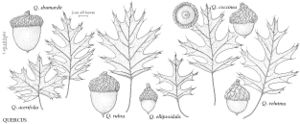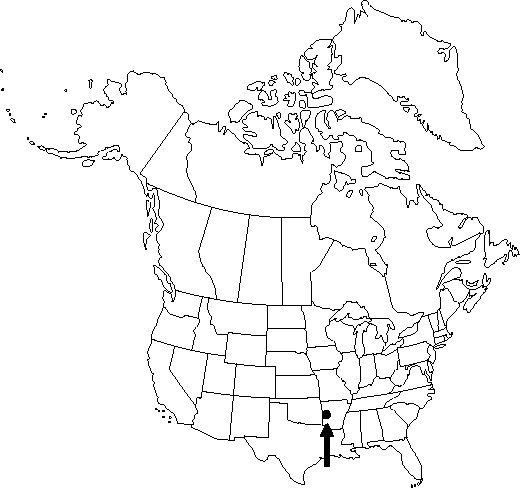Difference between revisions of "Quercus acerifolia"
Fl. N. Amer. 3: 465. 1997.
FNA>Volume Importer |
FNA>Volume Importer |
||
| Line 1: | Line 1: | ||
{{Treatment/ID | {{Treatment/ID | ||
|accepted_name=Quercus acerifolia | |accepted_name=Quercus acerifolia | ||
| − | |accepted_authority=(E. J. Palmer) Stoynoff & W. J. Hess | + | |accepted_authority=(E. J. Palmer) Stoynoff & W. J. Hess ex R. J. Jensen |
|publications={{Treatment/Publication | |publications={{Treatment/Publication | ||
| − | |title= | + | |title=Fl. N. Amer. |
| − | |place= | + | |place=3: 465. 1997 |
| − | |year= | + | |year=1997 |
}} | }} | ||
|common_names=Maple-leaf oak | |common_names=Maple-leaf oak | ||
| Line 30: | Line 30: | ||
}}<!-- | }}<!-- | ||
| − | --><span class="statement" id="st- | + | --><span class="statement" id="st-undefined" data-properties=""><b>Trees </b>or shrubs, deciduous, to 15 m. <b>Bark</b> dark gray to almost black, sometimes becoming rough and furrowed. <b>Twigs</b> grayish brown to reddish brown, 1.5-3(-3.5) mm diam., glabrous or sparsely pubescent. <b>Terminal</b> buds gray to grayish brown, ovoid or broadly ellipsoid, 3.5-5.5 mm, glabrous. <b>Leaves</b>: petiole 20-45 mm, glabrous. <b>Leaf</b> blade oblate to broadly elliptic, 70-140 × (60-)100-150(-180) mm, base cordate-truncate to obtuse, margins with 5-7(-9) lobes and 11-48 awns, lobes ovate-oblong or markedly distally expanded, the middle or apical pairs often overlapping, apex acute; surfaces abaxially glabrous or with prominent axillary tufts of tomentum, occasionally with scattered pubescence, adaxially glabrous, secondary veins raised on both surfaces. <b>Acorns</b> biennial; cup saucer- to cup-shaped, 4-7 mm high × 10-20 mm wide, covering 1/4-1/3 nut, outer surface glabrous or puberulent, inner surface light brown to red-brown, glabrous or with ring of pubescence around scar, scales often with pale margins, tips tightly appressed, obtuse or acute; nut ovoid to oblong, 10.5-20 × 9-15 mm, glabrous or pubescent, scar diam. 5-9 mm.</span><!-- |
-->{{Treatment/Body | -->{{Treatment/Body | ||
| Line 48: | Line 48: | ||
name=Quercus acerifolia | name=Quercus acerifolia | ||
|author= | |author= | ||
| − | |authority=(E. J. Palmer) Stoynoff & W. J. Hess | + | |authority=(E. J. Palmer) Stoynoff & W. J. Hess ex R. J. Jensen |
|rank=species | |rank=species | ||
|parent rank=section | |parent rank=section | ||
| Line 59: | Line 59: | ||
|distribution=Ark. | |distribution=Ark. | ||
|reference=None | |reference=None | ||
| − | |publication title= | + | |publication title=Fl. N. Amer. |
| − | |publication year= | + | |publication year=1997 |
|special status=Conservation concern;Endemic;Selected by author to be illustrated | |special status=Conservation concern;Endemic;Selected by author to be illustrated | ||
| − | |source xml=https://jpend@bitbucket.org/aafc-mbb/fna- | + | |source xml=https://jpend@bitbucket.org/aafc-mbb/fna-data-curation.git/src/9216fc802291cd3df363fd52122300479582ede7/coarse_grained_fna_xml/V3/V3_2.xml |
|genus=Quercus | |genus=Quercus | ||
|section=Quercus sect. Lobatae | |section=Quercus sect. Lobatae | ||
|species=Quercus acerifolia | |species=Quercus acerifolia | ||
| − | |||
| − | |||
| − | |||
| − | |||
| − | |||
| − | |||
| − | |||
| − | |||
| − | |||
| − | |||
| − | |||
| − | |||
| − | |||
| − | |||
| − | |||
| − | |||
| − | |||
| − | |||
| − | |||
| − | |||
| − | |||
| − | |||
| − | |||
| − | |||
| − | |||
| − | |||
| − | |||
| − | |||
| − | |||
| − | |||
| − | |||
| − | |||
| − | |||
| − | |||
| − | |||
| − | |||
| − | |||
| − | |||
| − | |||
| − | |||
| − | |||
| − | |||
| − | |||
| − | |||
| − | |||
| − | |||
| − | |||
| − | |||
| − | |||
}}<!-- | }}<!-- | ||
-->[[Category:Treatment]][[Category:Quercus sect. Lobatae]] | -->[[Category:Treatment]][[Category:Quercus sect. Lobatae]] | ||
Revision as of 13:35, 27 July 2019
Trees or shrubs, deciduous, to 15 m. Bark dark gray to almost black, sometimes becoming rough and furrowed. Twigs grayish brown to reddish brown, 1.5-3(-3.5) mm diam., glabrous or sparsely pubescent. Terminal buds gray to grayish brown, ovoid or broadly ellipsoid, 3.5-5.5 mm, glabrous. Leaves: petiole 20-45 mm, glabrous. Leaf blade oblate to broadly elliptic, 70-140 × (60-)100-150(-180) mm, base cordate-truncate to obtuse, margins with 5-7(-9) lobes and 11-48 awns, lobes ovate-oblong or markedly distally expanded, the middle or apical pairs often overlapping, apex acute; surfaces abaxially glabrous or with prominent axillary tufts of tomentum, occasionally with scattered pubescence, adaxially glabrous, secondary veins raised on both surfaces. Acorns biennial; cup saucer- to cup-shaped, 4-7 mm high × 10-20 mm wide, covering 1/4-1/3 nut, outer surface glabrous or puberulent, inner surface light brown to red-brown, glabrous or with ring of pubescence around scar, scales often with pale margins, tips tightly appressed, obtuse or acute; nut ovoid to oblong, 10.5-20 × 9-15 mm, glabrous or pubescent, scar diam. 5-9 mm.
Phenology: Flowering spring.
Habitat: Dry glades, slopes, and ridge tops
Elevation: 500-800 m
Discussion
Of conservation concern.
Quercus acerifolia is known only from four localities in Arkansas: Magazine Mountain, Logan County; Porter Mountain, Polk County; Pryor Mountain, Montgomery County; and Sugarloaf Mountain, Sebastian County (N. Stoynoff and W. J. Hess 1990; G. P. Johnson 1992, 1994). Some specimens suggest hybridization with Q. marilandica and/or Q. velutina, but no hybrids have been reported.
Selected References
None.

